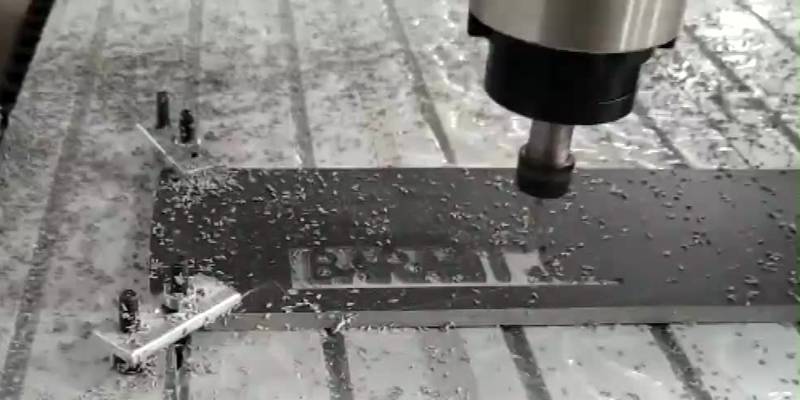- March 10, 2023
Engraving is an age-old manufacturing technique with a rich historical standing in mankind’s journey. It has seen incredible developments throughout history and has various, multi-faceted applications, particularly in the arts. Today, these developments have led us to CNC engraving, a process of significant importance.
This article offers an in-depth discussion of CNC engraving machining, its workflow, and its types. Additionally, we will also cover its benefits, material capabilities, and applications.
What is CNC Engraving?
Engraving is the process of gradually removing a small amount of material from a surface along a defined path. The process leaves a visible marking on the surface of the substrate (workpiece). CNC engraving is the modern version of engraving whereby automatic CNC technology guides the engraving tool with high accuracy and precision control.
Engraving machining has wide-ranging applications like decor and sign-making. Furthermore, it is compatible with a huge variety of materials and is a cost-effective process.
How CNC Engraving Works?
Let us dive a bit deeper into the world of engraving and see how it works in an industrial setting. The CNC engraving workflow is as follows:
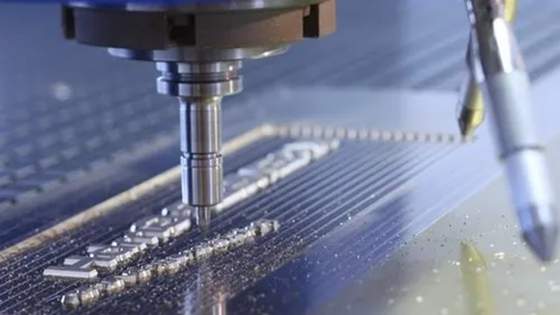
CAD: Initially, a designer creates a visualization of the engraving pattern on CAD software. The machinist must have a solid grip on CAD to be able to create complex patterns in a quick and accurate manner.
CAM: Computer Aided Manufacturing (CAM) software is a special software that is used to generate programs for the CNC engraving machine according to the CAD design. The CAD/CAM engineer uses this software to select relevant tooling for the engraving process, process parameters, and set tool paths. Finally, the CAM software generates a G-code file that is written in a syntax the CNC machine understands.
Setup: Before engraving machining begins, a machine operator sets up the workpiece in the machine. During this process, the workpiece placement and leveling are important to avoid manufacturing errors.
CNC Engraving: Finally, the engraving process begins. CNC technology is automatic so the technicians do not have to interfere much after some initial procedures. After the process ends, the workpiece is dismounted and the machine is ready for the next project.
Types of CNC Engraving
Now, we can move on to learn more about the different types of CNC engraving processes. While all of them achieve roughly similar results, they differ in many ways.
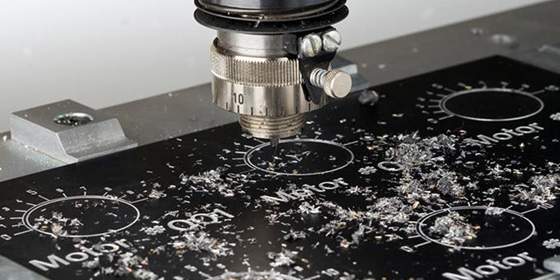
CNC Rotary Engraving
Rotary engraving utilizes a rotating cutting tool to remove material from the substrate. The cutting tool is quite similar to a normal machining tool and has cutting edges in the shape of flutes. Imagine how a drill bit spins and cuts through the material due to its sharp edges.
The shape and size of the cutters are important as they create grooves exactly like their shape. Common shapes are V-shaped and ball-end mills (rounded).
The CNC engraver has a special spindle to hold and rotate these rotary engraving tools. Generally, CNC engraving is a high-speed process with speeds as high as 20,000 RPM. Moreover, the depth of cut is in the range of 0.5-3 mm, depending on the material properties and design requirements.
These capabilities make CNC rotating engraving very versatile. Furthermore, it is also cheap and works with most materials.
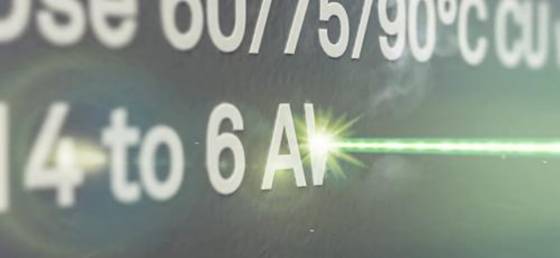
CNC Laser Engraving
CNC laser engraving is fundamentally different from rotary engraving. In this process, a high-intensity laser beam heats the substrate surface to a temperature where sublimation occurs (direct solid-to-gas phase change). Resultantly, it leaves an indentation on the surface.
The laser CNC engraving machine carries a laser head to produce the laser beam. The movement of this head is CNC-controlled, making this process remarkably precise and quick. Moreover, laser engraving is quite reliable and long-lasting as well.
Finally, we would like to take a small detour to clarify a common misconception people have between laser engraving, laser marking, and laser etching. Laser marking is quite similar to laser engraving, but with a much lower indentation depth. Hence, the word ‘marking’. Laser etching is a completely different process that uses a chemical reaction to remove material from the surface. It is a low-energy process compared to laser engraving.
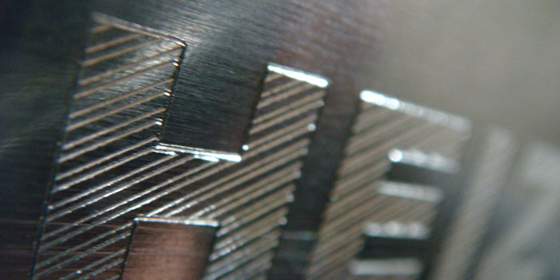
Diamond Drag Engraving
The name ‘diamond drag engraving’ is pretty self-explanatory. In this process, a sharp diamond tip drags across a surface to perform the engraving operation. Since diamond is the hardest known material, it is an efficient engraving tool. Moreover, diamond drag engraving does not involve tool rotation. Hence, the primary material removal process is scratching.
CNC diamond drag engraving is highly accurate and quick due to the precision control over the tool’s movements. Furthermore, the superior hardness of diamond makes it suitable for even the hardest metals.
Common Materials Used for Engraving Machining
Engraving machining is a diverse process in terms of material compatibility. Since its mechanics are not too extreme and depend on basic cutting/burning operations, it can CNC engrave a huge variety of materials.
In the following sections, we discuss the main material categories that a CNC engraving machine can conveniently handle.
Metals
Metals are typically the most common type of material found in CNC engraving shops. Engraving metal is like a less intense version of CNC milling, utilizing the same type of CNC cutters and cutting parameters. In fact, most CNC machines have served as engraving machines at some point in their service.
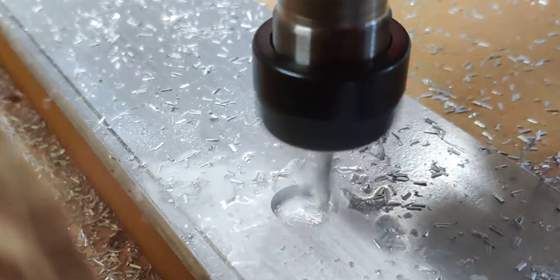
The same goes for laser engraving, where the primary purpose is not cutting the metal but engraving its surface.
However, metals are not always easy to machine and may require special tooling like coated cutters. Furthermore, metals are also more expensive than other engravable materials like plastics.
A list of metals that can be CNC engraved:
- Aluminum
- Steel & Stainless Steel
- Gold
- Brass
- Copper
- Silver
Apart from these common metals, one can also CNC engrave harder metals like titanium alloys. Generally, hardness is the most important property to look out for when CNC engraving as it defines how difficult it is to deform the surface. Consequently, for harder materials, high-performance engraving cutters or spring-loaded diamond cutters are recommended by experts.
Plastics
Plastics are another material group in CNC engraving machining. The name ‘plastics’ represents a large group of polymers, most of which are compatible with CNC engraving. Generally, thermoplastics are more suitable for engraving due to their outstanding thermal stability among other plastic groups.
Plastics are compatible with both CNC laser engraving and rotary engraving machining. Although, when it comes to plastics, laser engraving is the more popular choice. It is fast, low maintenance, and very accurate. However, there is an environmental hazard in some cases as some plastics burn with a fume which requires proper exhaustion from the facility.
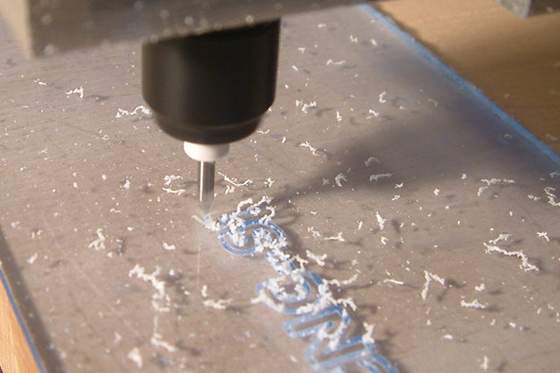
For rotary CNC engraving, plastic is not completely unknown either. Plastics are easy-to-cut materials that support very high cutting speeds and feeds. On the negative side, they create burr sometimes and may soften from cutting, limiting productivity. Managing these drawbacks yields excellent results.
Some common plastics for CNC engraving:
- Polyethylene
- Polystyrene
- Polyamide
- ABS
- Nylon
- Polyurethane
Wood
Wood engraving has many artistic applications like home decor, gifts, and luxury items. It is natural, soft, and generally the cheapest option among the materials we discussed. Furthermore, it is compatible with both laser and rotary CNC engraving machines.
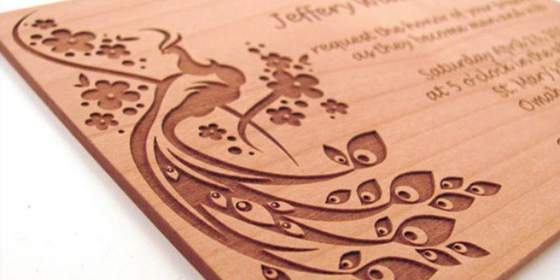
There are a few tips to keep in mind for wood engraving to avoid loss of time and money. Wood is an anisotropic material. This means that its properties are not consistent in all directions. Instead, they vary slightly with grain orientation, knots, and growth rings. Hence, keep these in mind when selecting wood for engraving projects.
Additionally, moisture and oil content can also negatively impact the effectiveness of a laser CNC engraver. Moreover, if you are using a rotary engraving machine, be wary of wood dust.
Common types of engravable woods include:
- Softwood
- Hardwood
- Balsa
- Birch
- Cork
Advantages of CNC Engraving
The widespread use of CNC engraving is a testament to the fact that it is a feasible process with several benefits. In this section, we highlight these advantages.
Precision and Accuracy
High precision and dimensional accuracy are the defining features of CNC technology. The same applies to a CNC engraver. The automatic CNC motion control can generate extremely precise engravings up to an impressive +/- 0.0025mm.
This level of accuracy is more than enough for most engraving machining applications.
Timesaving
In the old days of manual engraving, it took craftsmen hours or even days to complete one engraving project. They used hand tools and relied on their human skills to engrave, which was understandably time-consuming.
The modern-day CNC engraving machine, however, is automatic and fast. It engraves with rapid feeds and remarkable precision to achieve results within minutes.
Customization
The use of CAD/CAM software in CNC engraving allows quick and easy customization of engraving designs. Users have the opportunity of making changes in their CAD design and implement them immediately in the process.
This facility is a great convenience in shops specializing in rapid prototyping or multiple projects simultaneously. They can quickly eradicate mistakes or shift to a different design, boosting productivity.
Applications of CNC Engraving
CNC engraving has innumerable applications in a diverse range of industries. While we cannot cover all of them, the most important ones are briefly discussed below.
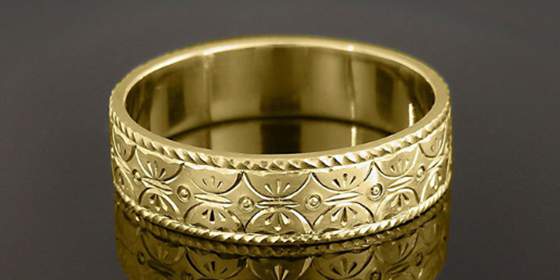
Sign Making: Road signs or advertisements are oftentimes a product of CNC engraving. It is permanent and can withstand different weather conditions. Hence, highly suitable for this application.
Jewelry: Jewelers CNC engraves items like pendants and bracelets to create eye-catching designs or personalized texts.
Industrial Marking: Nearly every industry has markings for equipment, safety, directions, etc. Engraving machining is a popular method of making durable and custom industrial markings.
Awards and Trophies: Trophies are always good with your name on them! Quite likely that name is there because of a CNC engraving machine.
Conclusion
CNC engraving is undoubtedly a crucial part of the modern manufacturing industry, boasting an extensive range of capabilities and applications. We can also enjoy appreciating the artistic patterns and helpful signs/markings ubiquitous in our surroundings. This is what engraving machining brings to the world!
WayKen is an industry leader in CNC engraving, offering professional machining services for your part’s markings and patterns. Feel free to contact us to discuss your projects with our experts.
FAQs
What is the difference between engraving and etching?
Engraving and etching both create the same result of removing some material from the workpiece’s surface. However, they rely on different physical phenomena. Engraving is a mechanical process that removes material by cutting it with a sharp tool. Etching is a chemical process that burns material off the surface.
Which software is used in a CNC engraving machine?
CNC engraving machines require CAD/CAM software to perform engraving tasks. The program allows the user to specify the engraving geometry, select the tool and cutting parameters, and the toolpath. Once finalized, it generates commands to pass on to the machine’s controller.
What cutters or bits are needed for CNC engraving?
CNC engraving uses cutters or bits similar to normal CNC machines. The most common type is the V-bit cutter which has a solid carbide tip. Full carbide cutters are also popular. For harder materials, diamond-tipped cutters are also used. If the design requires a rounded surface, ball end mills are used.

